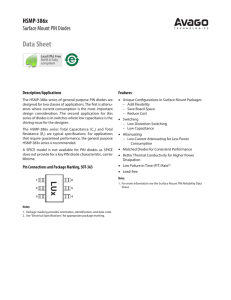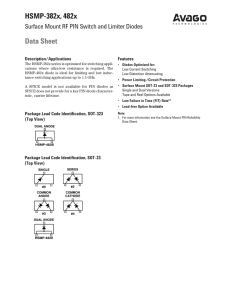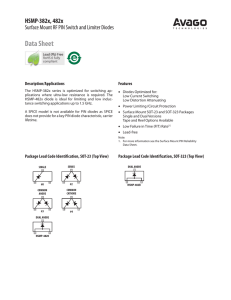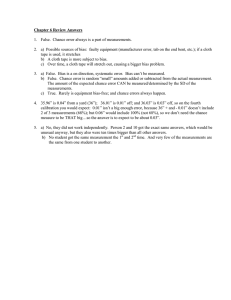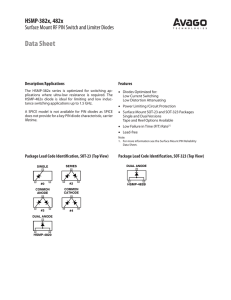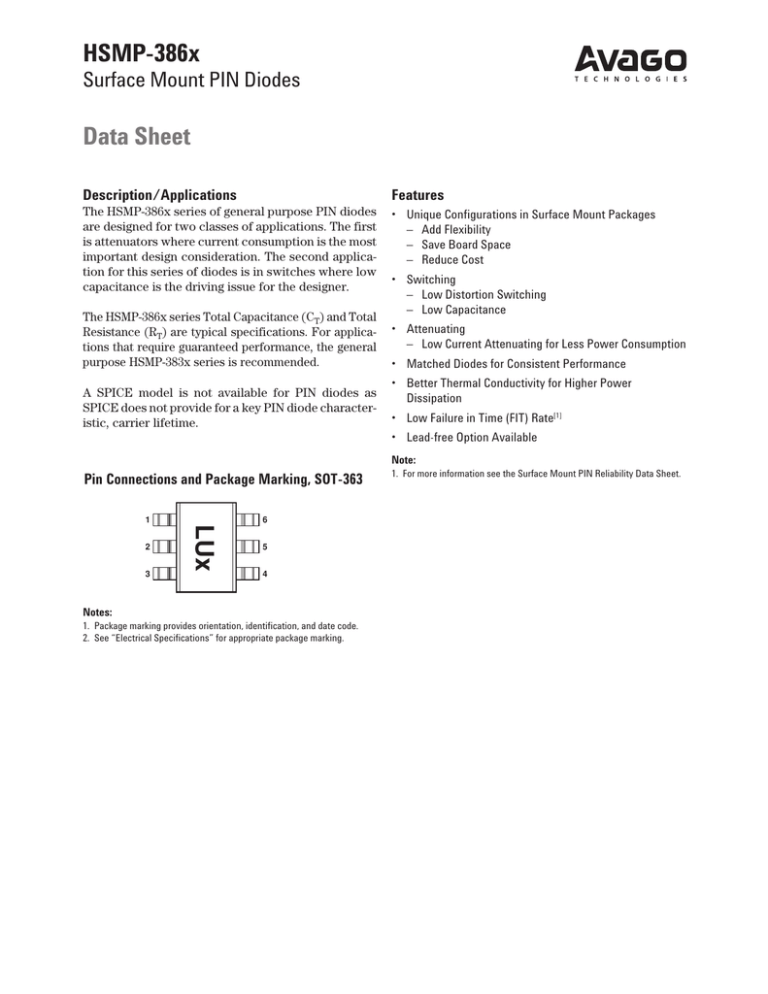
HSMP-386x
Surface Mount PIN Diodes
Data Sheet
Description/Applications
Features
The HSMP-386x series of general purpose PIN diodes
are designed for two classes of applications. The first
is attenuators where current consumption is the most
important design consideration. The second application for this series of diodes is in switches where low
capacitance is the driving issue for the designer.
• Unique Configurations in Surface Mount Packages
– Add Flexibility
– Save Board Space
– Reduce Cost
The HSMP-386x series Total Capacitance (CT) and Total
Resistance (RT) are typical specifications. For applications that require guaranteed performance, the general
purpose HSMP-383x series is recommended.
A SPICE model is not available for PIN diodes as
SPICE does not provide for a key PIN diode characteristic, carrier lifetime.
• Switching
– Low Distortion Switching
– Low Capacitance
• Attenuating
– Low Current Attenuating for Less Power Consumption
• Matched Diodes for Consistent Performance
• Better Thermal Conductivity for Higher Power
Dissipation
• Low Failure in Time (FIT) Rate[1]
• Lead-free Option Available
Note:
Pin Connections and Package Marking, SOT-363
2
3
LUx
1
6
5
4
Notes:
1. Package marking provides orientation, identification, and date code.
2. See “Electrical Specifications” for appropriate package marking.
1. For more information see the Surface Mount PIN Reliability Data Sheet.
2
Package Lead Code
Identification, SOT-23
(Top View)
SINGLE
Package Lead Code
Identification, SOT-323
(Top View)
SERIES
Package Lead Code
Identification, SOT-363
(Top View)
SERIES
SINGLE
#0
#2
B
C
COMMON
ANODE
COMMON
CATHODE
COMMON
ANODE
COMMON
CATHODE
#3
#4
E
F
UNCONNECTED
TRIO
6
5
1
2
4
3
L
Absolute Maximum Ratings[1] TC = +25°C
Symbol
If
Parameter
Unit
SOT-23
SOT-323
Forward Current (1 µs Pulse)
Amp
1
1
PIV
Peak Inverse Voltage
V
50
50
Tj
Junction Temperature
°C
150
150
Tstg
Storage Temperature
°C
-65 to 150
-65 to 150
qjc
Thermal Resistance[2]
°C/W
500
150
ESD WARNING:
Handling Precautions Should Be
Taken To Avoid Static Discharge.
Notes:
1. Operation in excess of any one of these conditions may result in permanent damage to the
device.
2. TC = +25°C, where TC is defined to be the temperature at the package pins where contact is
made to the circuit board.
Electrical Specifications TC = 25°C, each diode
PIN General Purpose Diodes, Typical Specifications TA = 25°C
Part Number
HSMP-
Package
Marking
Code
Lead
Code
3860
3862
3863
3864
386B
386C
386E
386F
386L
L0
L2
L3
L4
L0
L2
L3
L4
LL
0
2
3
4
B
C
E
F
L
Test Conditions
Configuration
Single
Series
Common Anode
Common Cathode
Single
Series
Common Anode
Common Cathode
Unconnected Trio
Minimum
Breakdown
Voltage VBR (V)
Typical
Series Resistance
RS (Ω)
Typical
Total Capacitance
CT (pF)
50
3.0 /1.5*
0.20
VR = VBR
Measure
IR ≤ 10 µA
IF = 10 mA
f = 100 MHz
VR = 50 V
f = 1 MHz
IF = 100 mA*
3
HSMP-386x Typical Parameters at TC = 25°C
Part Number
HSMP-
Total Resistance
RT (Ω)
Carrier Lifetime
t (ns)
Reverse Recovery Time
Trr (ns)
Total Capacitance
CT (pF)
386x
22
500
80
0.20
Test Conditions
IF = 1 mA
f = 100 MHz
IF = 50 mA
TR = 250 mA
VR = 10 V
IF = 20 mA
90% Recovery
VR = 50 V
f = 1 MHz
Typical Performance, TC = 25°C, each diode
1000
1 MHz
0.25
100 MHz
0.20
0.15
1 GHz
0
2
4
6
8
100
10
0.1
1
10
100
Figure 2. Typical RF Resistance vs.
Forward Bias Current.
1000
VR = 10 V
100
VR = 20 V
IF – FORWARD CURRENT (mA)
100
VR = 5 V
10
1
0.1
125°C 25°C –50°C
0.01
10
10
20
30
FORWARD CURRENT (mA)
Figure 4. Reverse Recovery Time vs.
Forward Current for Various Reverse
Voltages.
0
0.2
0.4
0.6
0.8
1.0
1.2
VF – FORWARD VOLTAGE (mA)
Figure 5. Forward Current vs.
Forward Voltage.
Equivalent Circuit Model
HSMP-386x Chip*
Rs
Rj
1.5 Ω
Cj
0.12 pF
110
Diode Mounted as a
Series Switch in a
50 Ω Microstrip and
Tested at 123 MHz
105
100
95
90
1
10
30
IF – FORWARD BIAS CURRENT (mA)
BIAS CURRENT (mA)
Figure 1. RF Capacitance vs. Reverse
Bias.
115
85
1
0.01
10 12 14 16 18 20
REVERSE VOLTAGE (V)
Trr – REVERSE RECOVERY TIME (ns)
INPUT INTERCEPT POINT (dBm)
0.30
120
TA = +85°C
TA = +25°C
TA = –55°C
RESISTANCE (OHMS)
TOTAL CAPACITANCE (pF)
0.35
RT = 1.5 + R j
CT = C P + C j
12
R j = 0.9 Ω
I
I = Forward Bias Current in mA
* See AN1124 for package models
Figure 3. 2nd Harmonic Input
Intercept Point vs. Forward Bias
Current for Switch Diodes.
4
Typical Applications for Multiple Diode Products
RF COMMON
RF COMMON
RF 2
RF 1
RF 1
RF 2
BIAS 1
BIAS
BIAS 2
BIAS
Figure 7. High Isolation SPDT Switch, Dual Bias.
Figure 6. Simple SPDT Switch, Using Only Positive
Current.
RF COMMON
RF COMMON
BIAS
RF 1
RF 2
RF 2
RF 1
BIAS
Figure 8. Switch Using Both Positive and Negative
Current.
Figure 9. Very High Isolation SPDT Switch, Dual Bias.
VARIABLE BIAS
RF IN/OUT
INPUT
FIXED
BIAS
VOLTAGE
Figure 10. Four Diode π Attenuator. See AN1048 for details.
5
Typical Applications for Multiple Diode Products (continued)
BIAS
“ON”
“OFF”
1
1
+V
0
2
0
+V
1
6
5
4
1
2
3
RF in
RF out
2
Figure 12. HSMP-386L Unconnected Trio used in a
Positive Voltage, High Isolation Switch.
Figure 11. High Isolation SPST Switch
(Repeat Cells as Required).
1
2
3
0
3
2
1
4
5
6
2
“ON”
“OFF”
1
b1
b2
3
2
1
4
5
6
1
0
0
2
+V
–V
1
b3
RF out
RF in
Figure 13. HSMP-386L used in a SP3T Switch.
Figure 14. HSMP-386L Unconnected Trio used in a
Dual Voltage, High Isolation Switch.
Ordering Information
Specify part number followed by option. For example:
HSMP - 386x - XXX
Bulk or Tape and Reel Option
Part Number; x = Lead Code
Surface Mount PIN
Option Descriptions
-BLK = Bulk, 100 pcs. per antistatic bag
-TR1 = Tape and Reel, 3000 devices per 7" reel
-TR2 = Tape and Reel, 10,000 devices per 13" reel
Tape and Reeling conforms to Electronic Industries RS-481, “Taping of
Surface Mounted Components for Automated Placement.”
For lead-free option, the part number will have the character "G" at the
end, eg. -TR2G for a 10K pc lead-free reel.
6
Assembly Information
SOT-323 PCB Footprint
Recommended PCB pad layouts for the miniature SOT
packages are shown in Figures 15, 16, 17. These layouts
provide ample allowance for package placement by
automated assembly equipment without adding
parasitics that could impair the performance.
0.026
SMT Assembly
Reliable assembly of surface mount components is a
complex process that involves many material, process,
and equipment factors, including: method of heating
(e.g., IR or vapor phase reflow, wave soldering, etc.)
circuit board material, conductor thickness and pattern,
type of solder alloy, and the thermal conductivity and
thermal mass of components. Components with a low
mass, such as the SOT package, will reach solder reflow
temperatures faster than those with a greater mass.
Avago’s diodes have been qualified to the time-temperature profile shown in Figure 18. This profile is
representative of an IR reflow type of surface mount
assembly process.
0.079
0.039
0.022
Dimensions in inches
Figure 15. Recommended PCB Pad Layout for Avago’s SC70
3L/SOT-323 Products.
0.026
0.079
0.039
0.018
Dimensions in inches
Figure 16. Recommended PCB Pad Layout for Avago’s SC70
6L/SOT-363 Products.
After ramping up from room temperature, the circuit
board with components attached to it (held in place
with solder paste) passes through one or more preheat
zones. The preheat zones increase the temperature of
the board and components to prevent thermal shock
and begin evaporating solvents from the solder paste.
The reflow zone briefly elevates the temperature sufficiently to produce a reflow of the solder.
The rates of change of temperature for the ramp-up and
cool-down zones are chosen to be low enough to not
cause deformation of the board or damage to components due to thermal shock. The maximum temperature
in the reflow zone (TMAX) should not exceed 235°C.
These parameters are typical for a surface mount assembly process for Avago diodes. As a general guideline, the
circuit board and components should be exposed only
to the minimum temperatures and times necessary to
achieve a uniform reflow of solder.
0.039
1
0.039
1
250
TMAX
0.079
2.0
0.035
0.9
0.031
0.8
Dimensions in inches
mm
TEMPERATURE (°C)
200
150
Reflow
Zone
100
Preheat
Zone
Cool Down
Zone
50
0
0
60
120
180
TIME (seconds)
Figure 17. Recommended PCB Pad Layout for Avago’s SOT-23
Products.
Figure 18. Surface Mount Assembly Profile.
240
300
7
Package Dimensions
Outline 23 (SOT-23)
Outline SOT-323 (SC-70, 3 Lead)
e1
e2
e1
E
E1
XXX
E
e
XXX
E1
L
B
e
C
D
DIMENSIONS (mm)
SYMBOL
A
A1
B
C
D
E1
e
e1
E
L
A
A1
Notes:
XXX-package marking
Drawings are not to scale
B
MIN.
MAX.
0.80
1.00
0.00
0.10
0.15
0.40
0.10
0.20
1.80
2.25
1.10
1.40
0.65 typical
1.30 typical
1.80
2.40
0.425 typical
A1
DIMENSIONS (mm)
HE
E
e
D
Q1
A2
b
MIN.
MAX.
1.15
1.35
1.80
2.25
1.80
2.40
0.80
1.10
0.80
1.00
0.00
0.10
0.10
0.40
0.650 BCS
0.15
0.30
0.10
0.20
0.10
0.30
c
A
DIMENSIONS (mm)
A
Notes:
XXX-package marking
Drawings are not to scale
SYMBOL
E
D
HE
A
A2
A1
Q1
e
b
c
L
C
D
Outline 363 (SC-70, 6 Lead)
A1
L
L
Package Characteristics
Lead Material ............................ Copper (SOT-323/363); Alloy 42 (SOT-23)
Lead Finish ................................... Tin-Lead 85-15% (Non lead-free option)
or Tin 100% (Lead-free option)
Maximum Soldering Temperature .............................. 260°C for 5 seconds
Minimum Lead Strength .......................................................... 2 pounds pull
Typical Package Inductance .................................................................. 2 nH
Typical Package Capacitance .............................. 0.08 pF (opposite leads)
SYMBOL
A
A1
B
C
D
E1
e
e1
e2
E
L
MIN.
0.79
0.000
0.37
0.086
2.73
1.15
0.89
1.78
0.45
2.10
0.45
MAX.
1.20
0.100
0.54
0.152
3.13
1.50
1.02
2.04
0.60
2.70
0.69
8
Device Orientation
REEL
CARRIER
TAPE
USER
FEED
DIRECTION
COVER TAPE
For Outlines SOT-23, -323
For Outline SOT-363
TOP VIEW
END VIEW
TOP VIEW
4 mm
8 mm
ABC
ABC
END VIEW
4 mm
ABC
8 mm
ABC
Tape Dimensions and Product Orientation
For Outline SOT-23
P2
D
E
P0
F
W
D1
t1
Ko
9° MAX
13.5° MAX
8° MAX
B0
A0
DESCRIPTION
SYMBOL
ABC
ABC
ABC
Note: "AB" represents package marking code.
"C" represents date code.
Note: "AB" represents package marking code.
"C" represents date code.
P
ABC
SIZE (mm)
SIZE (INCHES)
CAVITY
LENGTH
WIDTH
DEPTH
PITCH
BOTTOM HOLE DIAMETER
A0
B0
K0
P
D1
3.15 ± 0.10
2.77 ± 0.10
1.22 ± 0.10
4.00 ± 0.10
1.00 + 0.05
0.124 ± 0.004
0.109 ± 0.004
0.048 ± 0.004
0.157 ± 0.004
0.039 ± 0.002
PERFORATION
DIAMETER
PITCH
POSITION
D
P0
E
1.50 + 0.10
4.00 ± 0.10
1.75 ± 0.10
0.059 + 0.004
0.157 ± 0.004
0.069 ± 0.004
CARRIER TAPE
WIDTH
THICKNESS
W
t1
8.00 +0.30 –0.10
0.229 ± 0.013
0.315 +0.012 –0.004
0.009 ± 0.0005
DISTANCE
BETWEEN
CENTERLINE
CAVITY TO PERFORATION
(WIDTH DIRECTION)
F
3.50 ± 0.05
0.138 ± 0.002
CAVITY TO PERFORATION
(LENGTH DIRECTION)
P2
2.00 ± 0.05
0.079 ± 0.002
Tape Dimensions and Product Orientation
For Outlines SOT-323, -363
P
P2
D
P0
E
F
W
C
D1
t1 (CARRIER TAPE THICKNESS)
Tt (COVER TAPE THICKNESS)
K0
An
A0
DESCRIPTION
B0
SYMBOL
SIZE (mm)
SIZE (INCHES)
CAVITY
LENGTH
WIDTH
DEPTH
PITCH
BOTTOM HOLE DIAMETER
A0
B0
K0
P
D1
2.40 ± 0.10
2.40 ± 0.10
1.20 ± 0.10
4.00 ± 0.10
1.00 + 0.25
0.094 ± 0.004
0.094 ± 0.004
0.047 ± 0.004
0.157 ± 0.004
0.039 + 0.010
PERFORATION
DIAMETER
PITCH
POSITION
D
P0
E
1.55 ± 0.05
4.00 ± 0.10
1.75 ± 0.10
0.061 ± 0.002
0.157 ± 0.004
0.069 ± 0.004
CARRIER TAPE
WIDTH
THICKNESS
W
t1
8.00 ± 0.30
0.254 ± 0.02
0.315 ± 0.012
0.0100 ± 0.0008
COVER TAPE
WIDTH
TAPE THICKNESS
C
Tt
5.4 ± 0.10
0.062 ± 0.001
0.205 ± 0.004
0.0025 ± 0.00004
DISTANCE
CAVITY TO PERFORATION
(WIDTH DIRECTION)
F
3.50 ± 0.05
0.138 ± 0.002
CAVITY TO PERFORATION
(LENGTH DIRECTION)
P2
2.00 ± 0.05
0.079 ± 0.002
FOR SOT-323 (SC70-3 LEAD)
An
ANGLE
FOR SOT-363 (SC70-6 LEAD)
An
8°C MAX
10°C MAX
For product information and a complete list of distributors, please go to our web site:
www.avagotech.com
Avago, Avago Technologies, and the A logo are trademarks of Avago Technologies, Limited in the United States and other countries.
Data subject to change. Copyright © 2007 Avago Technologies, Limited. All rights reserved. Obsoletes 5989-4028EN
AV02-0293EN - April 9, 2007

